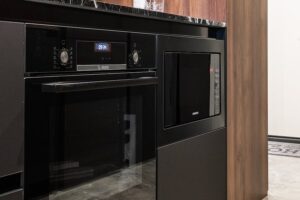When baking cakes, choosing the best oven is essential in achieving our cake goals. We want a range that delivers the ideal cake with a tender crumb, moist, and beautifully golden crust.

Different ovens exist now, each promising unique features and functionalities. It might be confusing to choose the ideal range without being influenced by many advertisements online.
Whether you’re baking for business or home, worry no more because it’s not difficult to identify the different types of ovens and their purpose.
In this article, we will walk you through the best types of ranges to use for baking delicious cakes and how to find the right one that suits your preferences.
Choosing the Best Oven for Baking Cakes
Many quality ovens are found online, but the question is, is this even the right oven you are looking for? When thinking about the outcome of your cake, you don’t want a single range to disappoint you.
The ideal and the best range can significantly affect the texture, rise, and overall quality of your cakes.
Don’t worry because each type of oven offers unique features and purpose. This is why we must know the different types of ovens in terms of baking process, heat distribution, temperature control, and cooking time.
The following are the leading and best ovens for baking cakes:
Conventional Oven
This traditional or standard oven is one of the popular choices for baking cakes. It generates heat using heating elements at the oven’s top and bottom.
The heat rises naturally, creating a consistent temperature inside the oven. Conventional ovens provide reliable and even heat distribution, making them suitable for baking cakes with consistent results.
They are versatile, accommodating various cake sizes and types, from layer cakes to bundt cakes.
However, it’s important to note that conventional ovens may have hot spots, so rotating the cake halfway through the baking process is recommended for even browning.
Convection Oven
A convection oven is an excellent option for baking cakes because it can circulate hot air using a fan. This constant airflow ensures even heat distribution, resulting in cakes with uniform baking and browning.
Convection ovens are particularly beneficial for multi-layer cakes as they simultaneously provide consistent heat to all layers.
The circulating air also helps cakes rise evenly, reducing the risk of doming or sinking in the center. In addition to that, this kind of oven has a faster baking time, which is already a big plus.
It is perfect for business baker selling cakes. Adjusting the baking temperature and time is essential since the circulating air quickly bakes the cake compared to a conventional oven.
Steam Oven
Steam ovens are gaining popularity among bakers for their ability to create moist and tender cakes. These ovens inject steam into the baking chamber during the cooking process, helping to retain moisture in the cake.
Steam ovens are particularly beneficial for delicate cakes, such as sponge cakes or chiffon cakes, as they prevent excessive drying and promote a soft texture.
The steam also aids in achieving a golden crust while maintaining a moist interior.
Don’t forget to keep in mind that steam ovens are not as flexible as conventional or convection ovens for other kinds of baking tasks. So, thinking about your overall baking needs is crucial before rightly investing in one.
Combination Oven
Combination ovens, as the name suggests, combine the functionalities of multiple oven types. They typically offer conventional, convection, and steam cooking modes in a single unit.
Combination ovens are versatile and allow bakers to choose the appropriate method for their specific cake recipes.
For instance, you can use the conventional mode for standard cakes, convection mode for even baking, and steam mode for achieving moist and tender cakes.
This type of oven is highly recommended for professional bakers or those who want to experiment with different baking techniques. However, they tend to be more expensive than standalone ovens.

Electric Ovens
Electric ovens are indeed excellent for baking cakes. They are popular among home bakers and professionals due to their precise temperature control and heat distribution.
Electric ovens typically feature heating elements at the oven cavity’s top and bottom. When baking cakes in an electric oven, the heat from the heating elements penetrates the cake batter, causing it to rise and cook.
The radiant heat surrounds the cake, baking it from the outside in. The consistent heat distribution ensures that the cake bakes evenly throughout, resulting in a moist and tender crumb.
Preheating the electric oven to the recommended temperature before placing the cake inside is essential. Its even heat distribution ensures that cakes bake uniformly, without hot spots or uneven browning.
Identifying the Suitable Oven
Identifying the suitable oven for the cake you will bake for several reasons. Firstly, in terms of budget, choosing the right oven ensures that you make a wise investment.
Different oven types come with varying price ranges, and selecting one that aligns with your budget allows you to get the best value for your money.
By understanding your baking needs and preferences, you can prioritize the most important features to you, ensuring that you invest in an oven that meets your requirements without overspending.
To identify the suitable type of oven for the cake you will bake, consider the following factors:
1. Recipe Requirements
Start by reviewing the recipe for your cake. Some recipes may specify the type of oven they are designed for, such as conventional, convection, or steam. Follow the recipe’s recommendations as a starting point.
2. Baking Needs
Consider your specific baking needs and preferences. Are you looking for an oven that can handle various cakes and baking tasks?
Do you need a versatile oven with multiple cooking modes? Assess your baking habits and requirements to determine essential features and functionalities.
3. Heat Distribution
Evaluate the heat distribution capabilities of different oven types. Consider options like convection or combination ovens if you want even heat distribution.
A conventional oven may be suitable if you prefer the traditional baking experience.
4. Moisture Control
Think about the level of moisture control you desire for your cakes. If you want to retain moisture and achieve a soft texture, steam ovens or ovens with steam injection capabilities may be worth considering.
5. Temperature Control

Assess the temperature control features of different oven types. Precise temperature control is crucial for baking cakes.
Look for ovens that offer accurate temperature settings and the ability to maintain consistent temperatures throughout the baking process.
6. Space and Budget
Consider the available space in your kitchen and your budget. Determine whether you have room for a built-in wall oven or if a countertop oven would be more suitable.
Additionally, factor in your budget and choose an oven that aligns with your financial constraints.
7. Research and Reviews
Research different oven models and read customer reviews to gather insights into their performance and reliability. Look for feedback related explicitly to baking cakes to understand how well the ovens perform.
Considering the factors above, you can narrow down the options and identify the most suitable type of oven for the cake you will be baking.
Remember that personal preferences and baking goals are significant in selecting the best oven for your needs, especially when you’re a business owner.
Conclusion
Selecting the right oven is crucial for perfect, moist, evenly baked, visually appealing cakes. The best type of oven for baking cakes depends on heat distribution, versatility, and personal preferences.
Conventional ovens offer reliable and even heat distribution, while convection ovens provide consistent baking and faster cooking times.
Steam ovens are ideal for creating moist and tender cakes, while combination ovens offer versatility with multiple cooking modes.
Additionally, considering the fuel source, such as electric or gas, is essential.
By understanding the characteristics and advantages of each oven type, you can make an informed decision and enjoy baking cakes that delight the senses.
